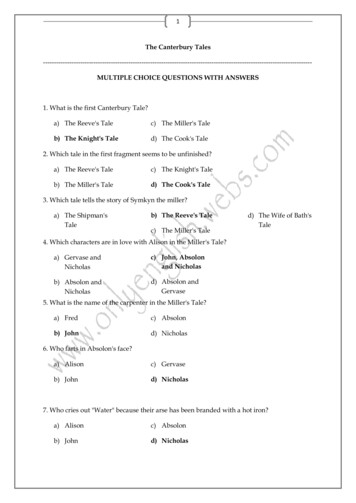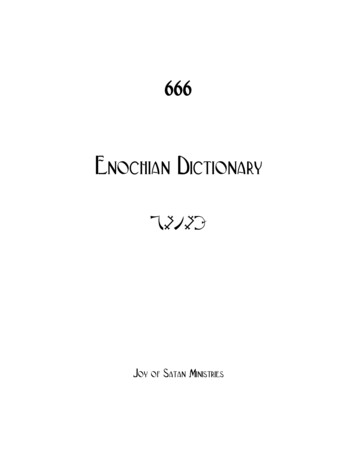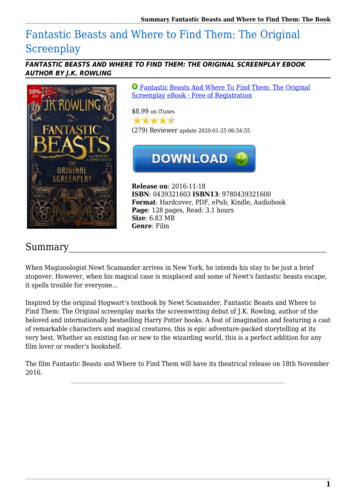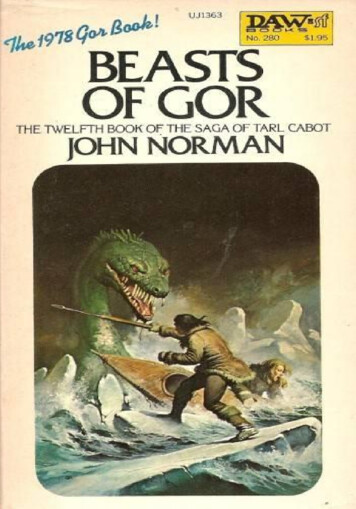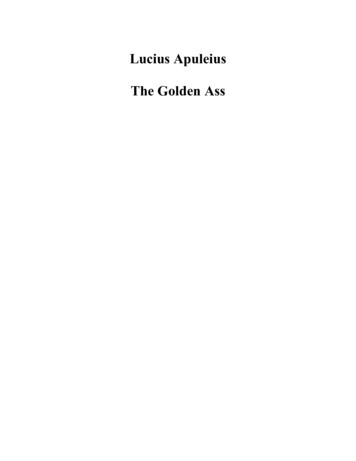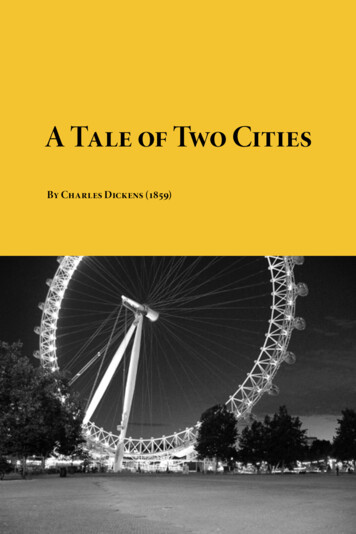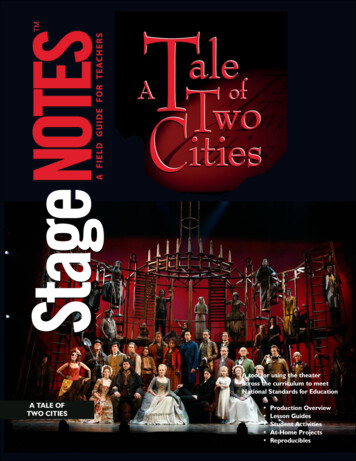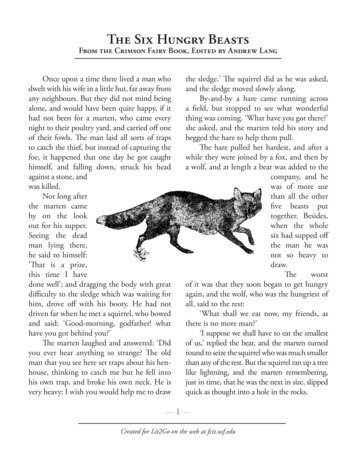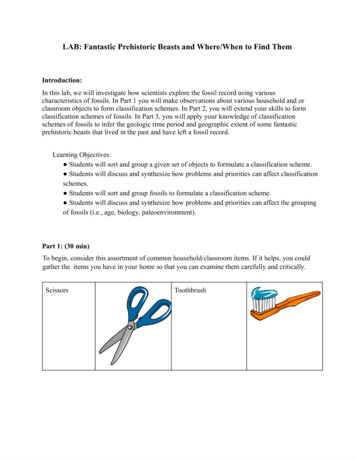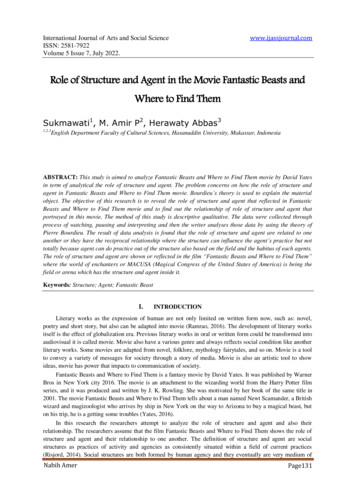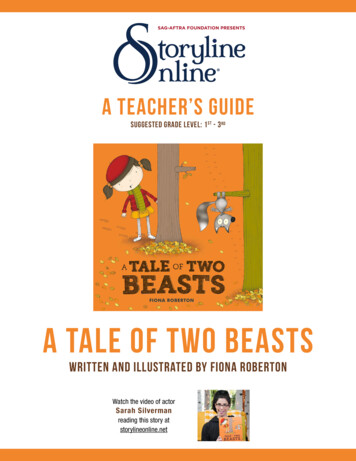
Transcription
a teacher’s guidesuggested grade level: 1 st - 3 rda tale of two beastswritten and illustrated by fiona robertonWatch the video of actorSarah Silvermanreading this story atstorylineonline.net
about this storySYNOPSISThere are two sides to every story. In Part One, a little girl finds a strange beast in the woods and takes ithome as a pet. She feeds it, shows it off to her friends and gives it a hat. But that night it escapes. Then,in Part Two, the beast tells the story of being kidnapped by the girl, who force-fed it squirrel food, scared itwith a group of beasts and wrapped it in wool. Can the two beasts resolve their differences? A Tale of TwoBeasts is an eye-opening story that makes you look at things from a different perspective.THEMES IN THE STORYSeeing the world in different ways, Making friends, EmpathyP A G E 2 A t e a c h e r ’ s G U I D E a ta l e o f t w o b e a s t s 2 0 1 8 S A G - A F T R A F O U N D A T I O NAbout This Guide: The purpose of this guide is to enhance the ELA curriculum by providing quality children’s literature to engagestudents in listening to expressive read alouds. Suggested story related activities are aligned with ELA Common Core Standards.
reading and writingSuggested grade level: 1 st - 3 rdela common core standardReading Literature: Students read and respond to works of literature with emphasis on comprehension, makingconnections among ideas and between texts with focus on textural evidence. Standards listed below are for 1 st , 2 ndand 3 rd grades but can be adapted to kindergarten standards.before viewingStandards:CCSS.SL.1.1, CCSS.SL.2.1, CCSS.SL.3.1Objective:Tap knowledge and build background for story.Procedure:Step 1:Ask students: What does it mean when we say there are two sides to every story? Discuss.Step 2:Explain to students that they will be listening to a story called, A Tale of Two Beasts by Fiona Roberton.Ask students to make predictions about the story based on the title.during viewingFocus:Listening, Making predictionsStandards:CCSS.SL.1.2, CCSS.SL.2.2, CCSS.SL.3.2, CCSS.RL.1.1, CCSS.RL.2.1, CCSS.RL3.1Objective:Students will listen to story and answer teacher posed questions appropriately.Procedure:Stop story at appropriate parts to ask questions or pose prompts. Suggestions are below:Beginning: Pause story and discuss quote by Mark Twain. Discuss characters.After first part: Who is telling the story? How do you know? How did the little girl’s feelings change about the animal from the beginning to theend of the story? The little girl asks, “I wonder why he came back?” Have students make predictions.After second part: Who is telling the story? How do you know? Why do you think the stories were so different? How were they the same? Did we find out the answer the little girl’s question: Why did he come back?(Yes - to get a hat)after viewing - Character Point of View/PerspectiveStandards:CCSS.RL.1.6, CCSS.RL.2.6, CCSS.RL.3.6Objective:Students will acknowledge differences in point of view based on a character’s perspective;Students will distinguish point of view from perspective.P A G E 3 A t e a c h e r ’ s G U I D E a ta l e o f t w o b e a s t s 2 0 1 8 S A G - A F T R A F O U N D A T I O NAbout This Guide: The purpose of this guide is to enhance the ELA curriculum by providing quality children’s literature to engagestudents in listening to expressive read alouds. Suggested story related activities are aligned with ELA Common Core Standards.
Materials:T-Chart (Google It!)White paperPencils, crayonsChart paperTeacher Prep:Prepare T-Chart for student worksheet: Title: Character’s Perspective. Label one column Little Girland the other column Animal. Make a large reproduction for whole class instruction.Create a largeFACT:FACT:FACT:FACT:FACT:FACT:FACT:FACT:STORY FACTS chart. List the following facts from the story.A little girl is walking in the woods and sees an animal hanging from a tree.The little girl takes the animal.The little girl wraps the animal in a scarf.The little girl takes the animal home and cares for it.The little girl shows him to her friends.The little girl opens the window.The animal leaves.The animal comes back.Procedure:Step 1:Explain the difference between Point of View and Perspective. Point of view: who is telling the story, or part of a story – who is giving the information. Perspective: How a character feels about something – the character’s take on whathappened based on attitude and beliefs.Step 2:Give an example to illustrate each term and discuss. Use a familiar event that happened where therewas more than one perspective (Ex: a disagreement between two students).Step 3:Tell students that the story, A Tale of Two Beasts, tells the same story from two different point ofviews: the little girl’s and the animal’s. The facts are the same but how each interpreted the facts arevery different, based on their perspective.Step 4:Show STORY FACTS chart. Explain that these facts are a summary of the story – they tell whathappened in the story. However, the point of view from which the story was told created two differentstories. The character’s perspective caused them to interpret the facts very differently.Step 5:Explain the T-Chart to students.Step 6:Model how to complete the activity using the first fact. List the perspective of each character on thechart as students follow alongStep 7:Guide the students using the second fact. List student responses on the chart as students do same.Step 8:Direct students to complete the T-chart with a partner using the remaining facts on the chart.Step 9:After students have finished the assignment, have them compare and contrast the stories throughclass discussion.Extension Activity: Students can create a comic strip telling the story from each character’s perspective.reading responseStandards:CCSS.RL.1.1, CCSS.RL.2.1, CCSS.RL.3.1Objective:Students will answer the prompt using at least two details from text to support the response.Reading Prompt: Compare and contrast the two stories. Tell two ways the stories are alike and two ways they aredifferent. Use details from the story to support your answer.P A G E 4 A t e a c h e r ’ s G U I D E a ta l e o f t w o b e a s t s 2 0 1 8 S A G - A F T R A F O U N D A T I O NAbout This Guide: The purpose of this guide is to enhance the ELA curriculum by providing quality children’s literature to engagestudents in listening to expressive read alouds. Suggested story related activities are aligned with ELA Common Core Standards.
writingStandards:CCSS.W.1.3, CCSS.W.2.3, CCSS.W.3.3CCSS.RL.1.6, CCSS.RL.2.6, CCSS.RL.3.6Objective:Students will write a narrative piece using grade appropriate sentence structure and spelling.Writing Prompt: The main character made a house for the animal and gave him Lord Rex to play with. To extend thelesson on point of view and character perspective, students retell the story, or part of the story, fromLord Rex’s point of view.Materials:Fact chart (created in reading lesson)Writing paper and toolsProcedure:First GradeStudents choose one fact from the STORY FACTS chart and rewrite that part of the story fromLord Rex’s point of view.Step 1:Discuss: Pretend you are the toy lion, Lord Rex. What story would you tell from your point of view?Step 2:Choose one fact from the STORY FACTS chart. Call on several students to give ideas on what LordRex’s point of view on this event might be.Step 3:Students choose a fact independently and discuss ideas about Lord Rex’s perspective of that eventwith a partner or group.Step 4:Draw a picture to illustrate fact, making sure to include Lord Rex (Ex: The little girl bathing the animalwith Lord Rex watching from his toy box.).Step 5:Write one or two sentences from the perspective of Lord Rex.Second/Third GradesStudents use the STORY FACTS chart to rewrite the story from Lord Rex’s point of view.Step 1:Ask students if the story would be different if told from the perspective of Lord Rex? Discuss.Step 2:Have students use the STORY FACTS chart to rewrite the story from beginning to end from theperspective of Lord Rex.Step 3:Use the Writing Process to complete assignment according to the abilities of your class.P A G E 5 A t e a c h e r ’ s G U I D E a ta l e o f t w o b e a s t s 2 0 1 8 S A G - A F T R A F O U N D A T I O NAbout This Guide: The purpose of this guide is to enhance the ELA curriculum by providing quality children’s literature to engagestudents in listening to expressive read alouds. Suggested story related activities are aligned with ELA Common Core Standards.
across the curriculum activitiesSCIENCE/TECHNOLOGYStudents research animals that hang upside down and write a report.LITERACY STANDARDS —CCSS.W.1.2, CCSS.W.2.2, CCSS.W.3.2CCSS.SL.1.2, CCSS.SL.2.2, CCSS.SL.3.2MATERIALS —Animal Graphic Organizer (Google It!)Computers/internet accessTeacher Prep:Google It!: Animals that hang upside down (Make a list of grade appropriate sites for studentresearch to have on hand)PROCEDURE —Step 1:Remind students that the animal in the story was found hanging upside down in a tree. Tap studentknowledge about animals that hang upside down.Step 2:Tell students that they are going to use the internet to find the names of animals that hang upsidedown and gather more information about them.Step 3:Explain and model how to use the internet for research.Step 4:Distribute the graphic organizer and explain.Step 5:Have students type in the search bar: Animals that hang upside down.Step 6:Assist students in finding the appropriate site to use and complete the organizer.Step 7:Type report on computer.Step 8:Instruct students on how to insert a picture into their report.Step 9:Print reports and hold a classroom presentation.Extension Activity: Have students make a diorama showing their animal in its natural habitat.SPEAKING – DEBATE ITMATERIALS —Fractured fairytales:Google It! to find a list of fairytales and YouTube videos.PROCEDURE —Step 1:Present the quote to students: There are two sides to every story, and then there is the truth.Discuss meaning with students.Step 2:Explain to students that they will be getting the other side of a fairytale by examining a familiarfairytale from the point of view of one of the minor characters. This version of a fairy tale iscalled a fractured fairytale. Fractured fairytales let us see the story in a new way because weare getting the facts from the perspective of another character, just like we saw in A Tale of TwoBeasts.Step 3:Present the original fairytale and the fractured fairytale to the class.P A G E 6 A t e a c h e r ’ s G U I D E a ta l e o f t w o b e a s t s 2 0 1 8 S A G - A F T R A F O U N D A T I O NAbout This Guide: The purpose of this guide is to enhance the ELA curriculum by providing quality children’s literature to engagestudents in listening to expressive read alouds. Suggested story related activities are aligned with ELA Common Core Standards.
Step 4:Ask students to think about who is more believable and why.Step 5:Hold a debate. Divide the class into two groups: Original Fairytale Believers vs Fractured Fairytale Believers. Guide the debate as students ask questions and present statements that support ordefend their point of view.Step 6:Connect the activity to everyday life. Ask students how they can apply what they have learned in this activityto their life.Extension Activity: Hold a mock trial.Google It!: Mock trial fragmented fairytales for more information.ART – PERSPECTIVEIn art, perspective is a method of creating an illusion of depth by using converging lines. Students use ahorizontal line to create near and far in drawing trees.MATERIALS —Drawing PaperRulerCrayonsPROCEDURE —Step 1:Explain the horizon line (the line where the land and sky seem to meet).Step 2:Allow students to look out the window to identify trees or other objects that are near and far.Discuss how they look.Step 3:Tell students that they are going to draw trees to create the illusion of near and far. This iscalled perspective.Step 4:Have students lightly draw a horizontal line about one third up from the bottom of the page.Step 5:Explain: Trees will appear closer if drawn below this line, closer to the bottom of the page; treesdrawn closer to the horizontal line will appear farther away.Step 6:Demonstrate concept for students.Step 7:Have students draw a sketch of three or four trees using this concept.Step 8:Color: Explain that the trees closer to the bottom of the page (near objects) should be coloreddarker. Trees that are closer to the horizontal line should be colored lighter to create the illusionthat they are far away.Step 9:Demonstrate on board.Step 10:Have students use color to complete artwork.P A G E 7 A t e a c h e r ’ s G U I D E a ta l e o f t w o b e a s t s 2 0 1 8 S A G - A F T R A F O U N D A T I O NAbout This Guide: The purpose of this guide is to enhance the ELA curriculum by providing quality children’s literature to engagestudents in listening to expressive read alouds. Suggested story related activities are aligned with ELA Common Core Standards.
about usabout storyline onlineThe SAG-AFTRA Foundation’s Emmy nominated children’s literacy program Storyline Online streamsimaginatively produced videos featuring celebrated actors to help inspire a love of reading. Storyline Online receives millions of views every month in hundreds of countries. Visit Storyline Online at storylineonline.net.about the sag-aftra foundationThe SAG-AFTRA Foundation provides vital assistance and educational programming to the professionals of SAG-AFTRAwhile serving the public at large through its signature children’s literacy program. Founded in 1985, the Foundationis a national non-profit organization that relies solely on support from grants, corporate sponsorships, and individualcontributions to fund our programs. Visit sagaftra.foundation.storyline online brought to you byP A G E 8 A t e a c h e r ’ s G U I D E a ta l e o f t w o b e a s t s 2 0 1 8 S A G - A F T R A F O U N D A T I O NAbout This Guide: The purpose of this guide is to enhance the ELA curriculum by providing quality children’s literature to engagestudents in listening to expressive read alouds. Suggested story related activities are aligned with ELA Common Core Standards.
Extension Activity: Students can create a comic strip telling the story from each character's perspective. Explain the difference between Point of View and Perspective. Point of view: who is telling the story, or part of a story - who is giving the information.

